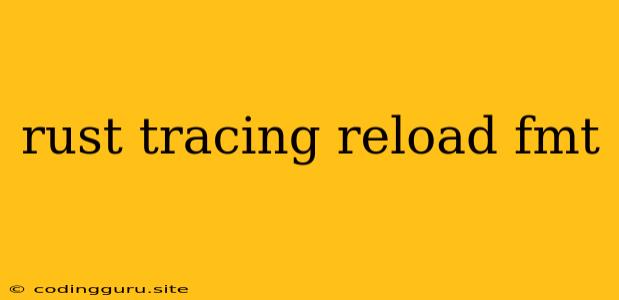Understanding Rust Tracing and How to Utilize fmt for Enhanced Logging
In the realm of Rust development, tracing emerges as a powerful tool for gaining insightful visibility into your application's behavior. It enables you to log events, track data flow, and diagnose problems with ease. But when it comes to shaping the output of your logs, fmt plays a crucial role.
What is Rust Tracing?
Rust Tracing, often referred to as just "tracing" within the Rust ecosystem, provides a robust framework for structured logging. It goes beyond simple print statements by offering a more organized and efficient approach to capturing and analyzing events. Think of it as a structured way to capture and understand what's happening within your application.
Why Use fmt for Tracing?
The core of tracing lies in its ability to emit structured events, commonly referred to as "spans". These spans encapsulate key details like the event's name, timestamps, and potentially other contextual information. While this structured information is invaluable, you need a way to present it in a human-readable format for effective analysis. Here's where fmt comes into play.
fmt in Action: Formatting Your Traces
Rust's fmt library, which you're probably already familiar with from working with println! macros, offers the flexibility to tailor your tracing output. It enables you to customize how your structured events are rendered, ensuring clarity and conciseness.
1. The Power of fmt with tracing::Subscriber
use tracing::{subscriber::set_global_default, Level};
use tracing_subscriber::{fmt, prelude::*};
fn main() {
let subscriber = fmt::Subscriber::builder()
.with_max_level(Level::DEBUG)
.finish();
set_global_default(subscriber).expect("Setting default subscriber failed");
tracing::debug!("This is a debug message");
tracing::info!("This is an informational message");
}
This code snippet demonstrates how to configure a fmt::Subscriber to control the logging output. The with_max_level method sets the minimum logging level to DEBUG, ensuring that only messages with a severity of DEBUG or higher are captured.
2. Customization with fmt::format::Writer
Let's consider a scenario where you want to customize the formatting of individual spans. fmt offers a Writer trait that enables you to define custom formatting logic.
use tracing::{span, Level};
use tracing_subscriber::fmt::{format::Writer, Subscriber};
use tracing_subscriber::prelude::*;
fn main() {
let subscriber = Subscriber::builder()
.with_max_level(Level::DEBUG)
.with_writer(MyCustomWriter)
.finish();
set_global_default(subscriber).expect("Setting default subscriber failed");
span!(Level::INFO, "my_span", name = "Some Value");
}
struct MyCustomWriter;
impl Writer for MyCustomWriter {
fn write_span(&self, span: &tracing::Span, f: &mut fmt::format::Formatter) -> std::fmt::Result {
write!(f, "Span: {} - Name: {}", span.metadata().name(), span.extensions().get::("name").unwrap())
}
}
In this example, we define a custom MyCustomWriter that implements the Writer trait. The write_span method allows us to format the span data as we see fit, including accessing custom extensions.
Tips and Considerations
-
Clarity is Key: Use meaningful names for your spans and events. This enhances the readability of your logs, making it easier to analyze them.
-
Structured Logs: Employ structured logging formats like JSON or YAML for easier parsing and analysis with tools like Elasticsearch or Splunk.
-
Context is King: Capture relevant contextual information within your spans to provide a richer understanding of the events being logged.
Conclusion
Rust Tracing provides a solid foundation for effective application monitoring and debugging, while fmt gives you the power to shape your logs into a readable and actionable format. By harnessing the capabilities of fmt, you can tailor your tracing output to meet your specific needs, enabling you to gain valuable insights into the inner workings of your Rust applications.
